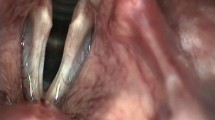Abstract
Benign vocal cord lesions affect vibratory vocal fold function resulting in significant dysphonia. A prospective study of 30 patients with benign vocal fold lesions was undertaken at our centre to compare the pre and post operative voice using videostroboscopy, voice analysis and voice handicap index. The vibratory pattern of the cord improved as evidenced by the stroboscopic parameters-symmetry, mucosal wave and glottic closure (p<0.05). Voice analysis showed a trend towards normalcy but the values obtained did not attain statistical significance. Voice handicap index showed a reduction in the total and the subscales scores. Videostroboscopy along with acoustic analysis and voice handicap index are useful tools in the objective and subjective assessment of the effectiveness of treatment in patients with benign vocal cord lesions. Their routine use in a voice clinic is recommended.
Similar content being viewed by others
References
Rosen CA. (2005) Stroboscopy as a research instrument: development of a perceptual evaluation tool. Laryngoscope 115:423–428
Colton RH, Woo P, Brewer DW, Griffin B, Casper J. (1995) Stroboscopic signs associated with benign lesions of the vocal folds. J Voice 9:312–325
Bless DM, Swift E. (1996) Stroboscopy: new diagnostic techniques and applied Physiology. In: Fried MP, ed. The Larynx a multidisciplinary approach. 2nd ed. St. Louis. Mosby-Year Book, Inc; p. 81–100
Korovin GS, Rubin JS. (2003) Introduction to the laboratory diagnosis of vocal disorders. In: Rubin JS, Sataloff RT, Korovin GS, eds. Diagnosis and treatment of voice disorders. 2nd ed. Australia. Thomson Delmar Learning; p 183–189
Jacobson BH, Johnson A, Grywalski C, Silbergleit A, Jacobson G, Benninger MS, et al. (1997) The voice handicap index (VHI): development and validation. Am J Speech Lang Pathol 6: 66–70
Wilson JA, Webb A, Carding PN, Steen IN, Mackenzie K, Deary IJ (2004) Voice symptom scale and the voice handicap index (VHI): a comparison of structure and content. Clin Otolaryngol 29:169–174
Deary IJ, Webb A, MacKenzie K, Wilson JA, Carding PN. (2004) Short, self-report voice symptom scales: psychometric characteristics of the voice handicap index-10 and the vocal performance questionnaire. Otolaryngol Head Neck Surg 31: 232–235
Loughran S, Calder N, MacGregor FB, Carding P, MacKenzie K. (2005) Quality of life and voice following endoscopic resection or radiotherapy for early glottic cancer. Clin Otolaryngol 30:42–47
Colton RH, Casper FK. (1996) In: Understanding voice problems: a physiological perspective for diagnosis and treatment. 2nd ed. Baltimore. Williams and Wilkins; p. 186–241
Koufmann JA and Issacson G. (1991) The spectrum of voice dysfunction. Otolaryngol Clin North Am 24:985–988
Woo P, Casper J, Colton R, Brewer D. (1994) Aerodynamic and stroboscopic findings before and after microlaryngeal phonosurgery. J Voice 6:66–70
Noordzij Jp, Woo P. (2000) Glottal area waveform analysis of benign vocal fold lesions before and after surgery. Ann Otol Rhinol Laryngol 109: 441–446
Koufman JA. (2003) Evaluation of laryngeal biomechanics by fibreoptic laryngoscopy. In: Rubin JS, Sataloff RT, Korovin GS, eds. Diagnosis and treatment of voice disorders. 2nd ed. Australia. Thomson Delmar Learning; 171–189
Woo P. (2003) Diagnosis and management of postoperative dysphonia. In: Rubin JS, Sataloff RT, Korovin GS, eds. Diagnosis and treatment of voice disorders. 2nd ed. Australia. Thomson Delmar Learning; p. 701–716
Lim J, Choi J, Kim K, Choi H. (2000) Voice analysis of patients with diverse types of Reinke’s edema and clinical use of electroglottographic measurements. Acta Otolaryngologica 126:62–69
Author information
Authors and Affiliations
Corresponding author
Rights and permissions
About this article
Cite this article
Thomas, G., Mathews, S.S., Chrysolyte, S.B. et al. Outcome analysis of benign vocal cord lesions by videostroboscopy, acoustic analysis and voice handicap index. Indian J Otolaryngol Head Neck S 59, 336–340 (2007). https://doi.org/10.1007/s12070-007-0096-0
Published:
Issue Date:
DOI: https://doi.org/10.1007/s12070-007-0096-0




